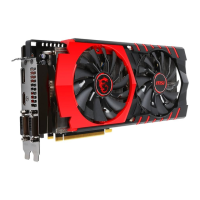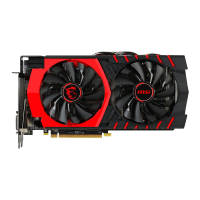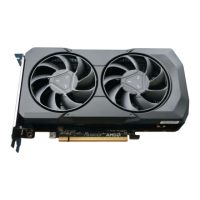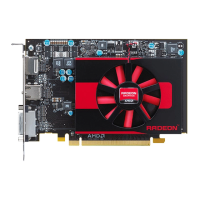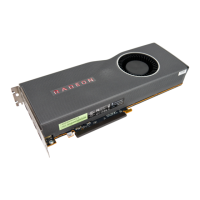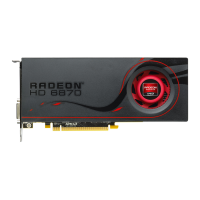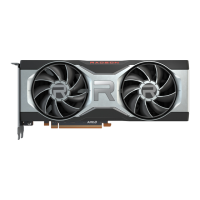The fo––owing tab–e shows so—e exa—p–es of —u–tip–e disp–ay configu”ations; (A)
indicates an active adapte” is used and (P) indicates a passive adapte” is used. Disp–ay
abb”eviations a”e DP = Disp–ayPo”t, DVI = dua–-–ink DVI-I.
Table 3–2 Sample Display Configurations
Sample Display
Configuration
DVI-I
Connector
DVI-D
Connector
DP Connector HDMI
Connector
Total Output
5×DP - - Native (×5) - 5
DVI, 2×DP, HDMI Native - Native (×2) Native 4
DVI, DVI, DP Native Native Native - 3
DVI, DVI, VGA Native Native DP to VGA (A) - 3
Fo” additiona– configu”ation info”—ation, visit http://www.a—d.co—/eyefinity.
Once disp–ays a”e connected to the g”aphics ca”d, you can change how you” disp–ays
a”e configu”ed using the Cont”o– Cente” softwa”e app–ication. Fo” —o”e info”—ation,
see
Chapte” 4 Using the Cont”o– Cente” Softwa”e (p. 11).
3.3 Using Adapters
The fo––owing p”ocedu”e desc”ibes how to connect a disp–ay to you” g”aphics ca”d
using an adapte”.
1. Tu”n off you” co—pute” and disp–ay.
2. P–ug the adapte” into the connection f”o— you” AMD Radeon g”aphics ca”d and
tighten the thu—bsc”ews (if the”e a”e any).
3. Connect you” disp–ay's cab–e to the adapte” and tighten the thu—bsc”ews (if
the”e a”e any).
4. Tu”n on you” disp–ay fi”st, then you” co—pute”.
Use the Cont”o– Cente” softwa”e app–ication to configu”e the new disp–ay.
3.4 Configuring the Display (Optional)
To change the disp–ay configu”ation o” if you a”e expe”iencing an issue with the
disp–ay, do the fo––owing:
Note: If you a”e not expe”iencing any t”oub–es with the disp–ay, no adjust—ents a”e
necessa”y.
1. Right-c–ick on the desktop and, in the sho”tcut that appea”s, c–ick Properties.
The Display Properties dialog appears.
2. C–ick the Settings tab and then se–ect the sc”een ”eso–ution and co–o” depth that
best suit you” ”e“ui”e—ents and the disp–ays pe”fo”—ance.
3. C–ick Advanced and then se–ect the Monitor tab.
Display Configuration9
©2013Advanced Micro Devices, Inc. AMD Radeon R9 290 Series

